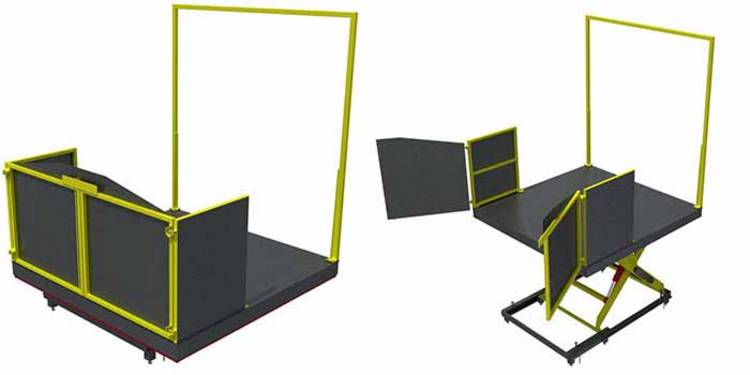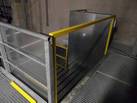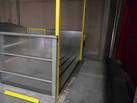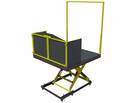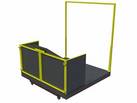This lift table is used in the Volkswagen AG Original Parts Centre in Baunatal. The automotive group invested in a new high-bay warehouse at the site near Kassel. The company uses a scissor lift table from our company for regular and unscheduled maintenance work.
Purpose
A height difference of approximately 1,500 mm between the high-bay warehouse and the adjacent building must be overcome to transport machinery and tools to the lower level of the warehouse for maintenance and repair work. Our scissor lift was designed for exactly this application. It can transport equipment weighing up to 1,500 kg on a floor area of approximately six square metres (2,500 mm x 2,500 mm).
Flexible adaptation to the place of use
We have specialised in customising our lifting systems to match your conditions. In this case, some local conditions also had to be taken into account when designing the lift table.
Customised dimensions
Manufacturing platforms according to customised dimensions is a matter of course for us. By tapping into a well thought-out modular system, customised platform dimensions can be easily implemented without a major increase in costs.
A capacity that was also required for this project. The dimensions of the pit were already known before the lift table was designed and a solution was sought that would fit exactly into this given dimension.
In addition to a customised platform width and length, the overall height also needed to be a specific measurement. In this case, the pit was constructed almost 90 mm deeper than would have been required for our design. However, this difference could easily be eliminated with a raised base frame.
Difficult to reach the installation site
Access to the installation site of the lift table posed quite a challenge. The actual installation site could only be reached through a 2.20-m-wide door. With the dimensions being approximately 2.5 m x 2.5 m, it quickly became clear that the lift table could not simply be pushed to the site.
So we built a separated platform. This means the platform can be disassembled into three parts and reassembled on site. The widest platform piece had a width of 1.80 m.
Operating the lift table
Because the lift table was not installed inside a shaft, it is equipped with a so-called dead man's control. This means that the platform only raises or lowers as long as the corresponding button is held down.
The lift table can be operated either directly from the platform or from one of the two landings. It should be noted that the control panel on the platform has a priority circuit so that, in case of doubt, the operator on the platform has control of the lift table.
As the lift table was installed at a very early stage and contact with rainwater could not be ruled out, both the operation and the control system were designed in protection class IP65. This provides adequate protection against any contact with water, thus preventing a short circuit or component failure.
External power unit
The use of an electro-hydraulic power unit provides great flexibility in selecting the installation site. Only an empty conduit of adequate size need to be laid between the lift table and the installation site and the unit can be placed in an adjacent room or in the unused space under a staircase, for example.
In this case, the customer also decided not to have the power unit in the lift table. this was done to improve accessibility to the control system and the under-oil unit. This is particularly advantageous if maintenance work has to be carried out on the lift table or individual parts of the drive unit have to be replaced.
Devices of the lift table
The lift table is equipped with a number of safety features to guarantee the safety of the operating personnel and bystanders. In this section we would like to introduce the most important ones.
Corrugated wire-mesh screen
This lift table has an effective stroke of 1,500 millimetres. With this effective stroke, a device should be installed to prevent persons from easily gaining access to the underside of the scissor lift table.
While sheet metal cladding on three sides of the lift table already acts as a barrier, only the front of the platform had to be secured. In this case, the customer requested a corrugated wire-mesh screen as a barrier. the advantage over bellows is that access is made more difficult but the view of the hazard zone is hardly restricted at all.
Pressure relief valve and pressure switch
Users are often not aware of the weight of the objects that need to be transported with the lift table. Independent safety devices therefore need to be installed to protect the mechanics and hydraulics against loads that are too heavy.
In the present case, we rely on a combination of pressure relief valve and pressure switch. The pressure relief valve prevents the platform from being raised if the load placed on the lift table in the bottom position is too heavy. If the pressure in the hydraulic circuit becomes too high, this valve ensures that the oil does not reach the cylinders, but is pumped directly back into the tank.
Unfortunately, the pressure relief valve fails if the lift table is not to be raised but lowered. For this reason, scissor lifts that can be loaded in the top position require another safety measure, a pressure switch, for example. It measures the current pressure in the hydraulic system and switches an output when an adjustable value is exceeded. This in turn is evaluated by a built-in programmable logic controller and ensures that the platform comes to an immediate standstill and the plant operator is notified accordingly.
Foot protection safety edge
As in 95% of all applications, this scissor lift also has a foot protection safety edge. It is mounted directly underneath the platform and prevents the platform from being lowered further when it is actuated. Of course, a lifting movement is still possible to free the clamped object or the person in danger.
Smooth sheet metal with anti-slip strips
If the lift table platform is walked on by persons, we usually use diamond or checker plate to prevent the risk of slipping. In this case, the end customer wanted a smooth platform surface to make it as easy as possible to push pallet trucks and trolleys onto it.
But despite the smooth surface, the risk of slipping must be eliminated. Anti-slip strips were provided on the platform for this reason.
Securing the operating site
The placement of the lift resulted in a number of hazards that had to be eliminated to meet the requirements of EN 1570-1.
Risk of crushing and shearing
The lift table is used to move loads between the lower level of the high-bay warehouse and a raised steel platform. As the platform is not cladded, there was a risk of crushing and shearing between the steel platform and the lift table platform. The same applied to the existing open railing on site and a load to be lifted. For this reason, we not only supplied the lift table, but also suitable guard plates to protect the previously existing crushing and shearing edges.
Risk of falling from the top landing
If the lift table is in the bottom position, there is a risk that a person could fall from the top landing. A multi-leaf door installed on the top landing would be the traditional way to solve this problem. However, as the door must be electromechanically locked and queried, it is associated with considerable costs.
This is the reason why we decided on a more cost-effective alternative here. EN 1570-1 allows the top landing to be secured by means of a gantry when the fall height is not more than 1,600 mm. This is mounted directly on the lift table platform and it complements the existing on-site enclosure in the bottom position. If the lift table moves to the top end position, the gantry also raises along with it, so that the platform can be loaded and unloaded without any problems and without cost-intensive installation work.
Risk of falling from the platform
The platform of the lift table is surrounded on three sides by an enclosure, leaving only one front side of the lift table to be secured. A platform railing was installed to avoid the risk of falling.
The platform can be loaded and unloaded through a double-leaf door that can only be opened when the lift table is in the bottom position. The control unit also checks whether the door has been closed properly before the lift table starts to move up.
Welded oil pan
If a lift table is installed outdoors in a pit, certain precautions need to be taken. For example, a drain must be provided to avoid a too high water level in the pit. At the same time, hydraulic oil must be prevented from seeping into the ground or the sewerage system from the pit. Therefore, the operator is usually obliged to install an oil separator inside the drain and to paint the concrete with a special paint that prevents the hydraulic oil from seeping through.
Due to the place of use, the situation that a rain shower or melt water will lead to an overflow of the lift table pit could be ruled out in this case. So, a drain has not been installed. Because an otherwise usual paint coat of the pit was not needed, we provided a welded oil pan which could be placed underneath the lift table as a solution. This oil pan can hold a volume of more than 300 litres. When you consider that the entire hydraulic system of the scissor lift table only uses 25 litres of hydraulic oil, it quickly becomes clear that there is no need to worry about the pan overflowing.
Biodegradable hydraulic oil
Apart from the oil pan, a safe pressure medium was also selected. Instead of conventional hydraulic oil, the lift table in the high-bay warehouse is driven by biodegradable hydraulic oil.
Other special features
To avoid the article on this project becoming too long-winded, the other special features of this project will only be briefly outlined.
Pit edge protection
The concrete edges of a pit have a distinct disadvantage: they break off easily when you run over them with a heavier load. For this reason, we always recommend inserting a steel angle frame to protect the edges when casting the concrete for the pit.
If this has not been done, we can supply you with a pit edge protection to retrofit as a solution. This can be fastened to the existing floor with anchor bolts to reliably protect the edge against excessive forces.
Maintenance opening in the platform
A maintenance opening must be provided in the platform of a lift table that is equipped with an internal power unit and that is installed in a pit. We place this directly above the control unit and the hydraulic power unit, so that in the worst case, manual operation or component replacement is possible.
Although Volkswagen AG's lift table has an external power unit, the company still decided to use a maintenance opening. This is located directly above the hydraulic cylinders allowing the cylinders to be reached in any position.
Hot-dip galvanising instead of painting
If you want your lift table to still look good even after intensive use, you should consider a hot-dip galvanised platform. This is especially true when the lift table platform is driven on for loading and unloading. The constant rolling movements will sooner or later cause the paint to flake off with a classic paint finish, whereas this effect is not detectable with a hot-dip galvanised platform.
The use of a hot-dip galvanised base frame is anyway recommended if the lift table is used outdoors and/or inside a pit. Even if the pit has a drain, this does not mean that it cannot be under water for short periods. Leaves or other debris can block the drain and the accumulated water will initially remain unnoticed in the pit. To prevent your lift table from being damaged by this, the base frame should be hot-dip galvanised instead of being painted.
Of course the entire lifting platform can also be galvanised. There is a photo of such an example in the first section under the heading galvanised scissor lifts..

